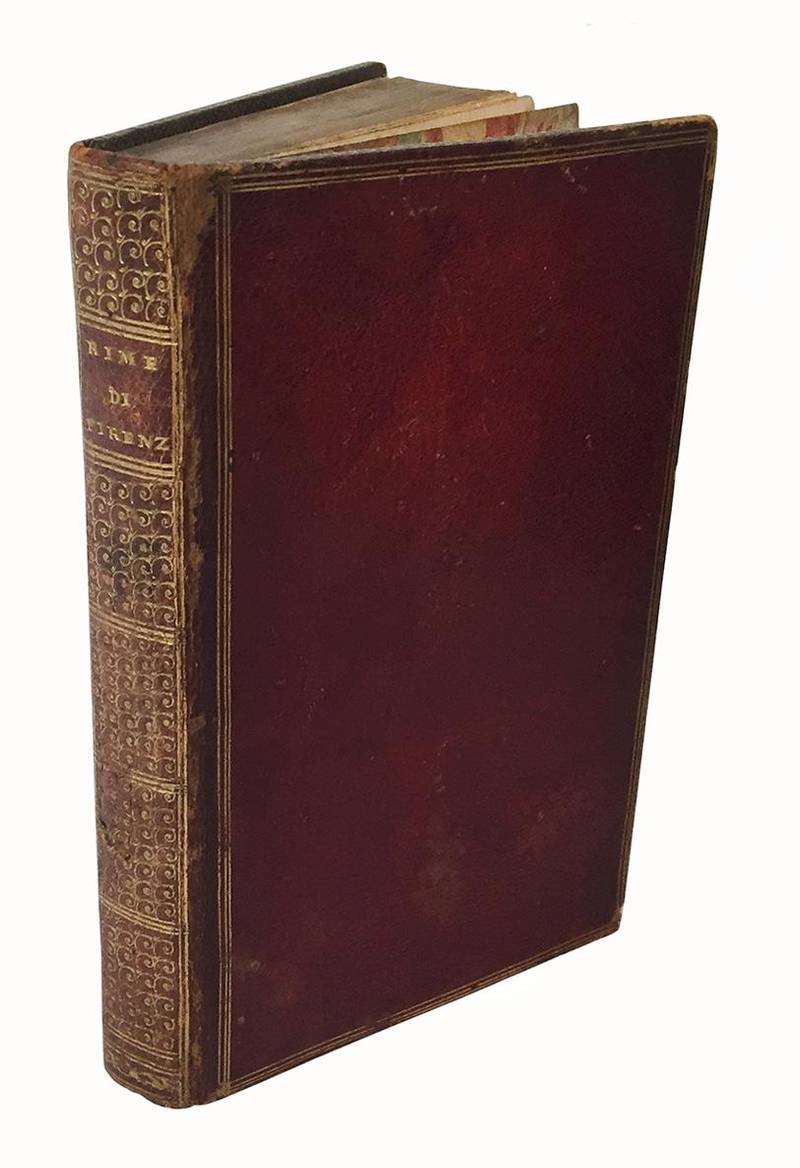8vo (mm 150x90). 135, [1] ll. Collation: A-R8. Printer's device on title page and on last leaf recto. Late 17th-centry or early 18th-century Italian morocco, panels within a triple gilt fillet, flat spine richly gilt with gilt title, marbled endleaves, inside gilt dentelles, gilt edges (small repair to spine and back panel, corners and hinges a bit worn). Minor scattered foxing, but a very good copy.
FIRST EDITION, published posthumously by Lorenzo Scala and by him dedicated to Francesco Miniati, of this fortunate collection of poetry.
The poems are addressed to Selvaggia (from the Prato family of the Buonamici, the woman loved by the poet), Annibal Caro, Camillo Tonti, Dada Buonvisa, to the women from Prato, Filippo Ciconini (in death of Bartolomeo Gerardacci), Vincenzo Visconti, Giovanfrancesco Buonamici, Domenico Perini, Verdespina, Santi Quattro, Clemenza Buonamici, Lucrezia Tornabuoni, Martinozzo, Inghirano, Pandolfo Pucci, Giovanni Lanciolina, Giovanbattista del Milanese, Leo Villani (a bricklayer), Guido Antonio Adimari, Lasca, and Gualterotto de Bardi. The volume contains also imitation poems from Horace, two elegies, a canzone in praise of the sausage, a song in praise of the holy wood, a chapter in praise of thirst, and one in the death of an owl.
At p. 60 it opens with a separate title-page the section Lagrime di Messer Agnolo Firenzuola nella violenta morte d'un giovane nobile napoletano, dedicated to the noblewoman from Prato Clemenza Roca. At p. 89 begins Il Sacrificio pastorale (cf. D. Maestri, Le rime di Agnolo Firenzuola: proposta di un ordinamento del testo e valutazione critica, in: “Italianistica”, III, 1974, pp. 78-96).
Agnolo Firenzuola, a native of Florence, following in the footsteps of his father, a notary, studied law at Siena and Perugia, where he met Claudio Tolomei and Pietro Aretino. Upon graduation, he took the holy habit at Vallombrosa and in 1518 moved to Rome, where he became the procurator of the order at the Curia. In Rome, he formed a literary circle with his Sienna and Arezzo friends and made the acquaintance of P. Bembo, A. Caro and G. Della Casa. In 1526 he was dispensed from his vows and contracted syphilis, a disease that plagued him for a long time. The main reason why he decided to give up the habit was the meeting with a cultivated Roman noblewoman, wife of a lawyer, whom Firenzuola praises in many of his works under the pseudonym of Constance Amaretta. In 1538 he moved to Prato, where he founded the Accademia dell'Addiaccio and embraced again the monastic life, becoming abbot of the Monastery of San Salvatore. In the last years he went through a legal dispute with his sister over their father's legacy and various quarrels with local families. Firenzuola died in absolute solitude at Prato on June 27, 1543.
All his works, except the Discacciamento de le lettere inutilmente aggiunte ne la lingua toscana (‘Expulsion of the letters unnecessarily added to the Tuscan language') published at Rome in 1524, were posthumously edited by his brother Girolamo, who entrusted L. Scala and L. Domenichi with the publication of Agnolo's papers: the Prose appeared in 1548; the comedies I Lucidi and Trinunzia in 1549; and the Asino d'oro (‘Golden Ass'), an adaptation from Apuleius' masterpiece, in 1550 (cf. F. Pignatti, Firenzuola, Agnolo, in: “Dizionario biografico degli Italiani”, XLVIII, 1997, s.v.).
Edit 16, CNCE19198; B. Gamba, Delle novelle italiane in prosa, Florence, 1835, no. 456; BMSTC Italian, p. 254; Adams, F-503; L.S. Camerini, I Giunti tipografi editori di Firenze, Florence, 1979, no. 263.
[5389]








